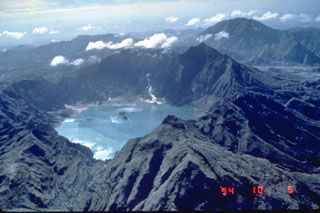Report on Pinatubo (Philippines) — May 1992
Bulletin of the Global Volcanism Network, vol. 17, no. 5 (May 1992)
Managing Editor: Lindsay McClelland.
Pinatubo (Philippines) Rains on 1991 deposits produce destructive mudflows
Please cite this report as:
Global Volcanism Program, 1992. Report on Pinatubo (Philippines) (McClelland, L., ed.). Bulletin of the Global Volcanism Network, 17:5. Smithsonian Institution. https://doi.org/10.5479/si.GVP.BGVN199205-273083
Pinatubo
Philippines
15.13°N, 120.35°E; summit elev. 1486 m
All times are local (unless otherwise noted)
Increased steam emission from Pinatubo's summit caldera was periodically observed in 1992, often accompanied by low-frequency harmonic tremors believed to be associated with sudden release of pressurized gas and steam from shallow depth. However, seismicity at the volcano continued to decline. Felt shocks with intensities of I-V (Rossi-Forel scale) were reported until mid-May.
Numerous mudflows descended the volcano's flanks, as heavy local rainfall mobilized large quantities of unconsolidated material deposited during the June 1991 eruption (16:5-6). The more significant events occurred on 18-19 February, 5 April, 10 and 31 May, and 1 and 4 June, affecting low-lying areas NE, SE, and SW of the volcano. Dams along the Pasig-Potrero and Sacobia rivers (SE and E flank, respectively) were destroyed during these relatively minor mudflow events and residents of Angeles (25 km E) reported slight to moderate ashfall from secondary explosions in pyroclastic-flow deposits within the Sacobia Pyroclastic Fan (SPF). Civil authorities have attempted to limit damage from the mudflows in the three provinces surrounding the volcano (Tarlac, Pampanga, and Zambales) by constructing Sabo dams and catchment basins, and by dredging channels, at a cost of more than $300,000,000. More than 250 school buildings were prepared as evacuation centers and the government advised people living near river banks to move to safer ground.
On 4 April, a major secondary explosion occurred at the toe of the SPF (drained by the Sacobia-Bamban and Abacan rivers), producing a 1.2-km-high ash plume. The explosion triggered a landslide that developed into a secondary pyroclastic flow, travelling 3 km down the Sacobia River and 2 km down the Abacan River. Numerous explosions followed, minutes apart. The secondary flow deposit, 14 m thick 3 km from the explosion site, buried three Sabo dams along the Abacan and two along the Sacobia River. A moderate amount of ashfall (~4 mm) was reported by residents at Clark Air Base/Pinatubo Volcano Observatory and Angeles. The flow left a deep escarpment, cutting the Abacan River off from the SPF, its source of mudflow material. The upper reaches of the river have been captured, and now flow down to the Sacobia-Bamban River, with only a muddy trickle expected to reach the Abacan.
With the advent of the rainy season (June-November), larger mudflows, with accompanying flooding and siltation, were expected in low-lying areas along the major river channels draining the volcano. As of early June, about 70,000 of the roughly 250,000 people displaced during the 1991 eruption and subsequent mudflows remained in evacuation centers and resettlement areas.
Geological Summary. Prior to 1991 Pinatubo volcano was a relatively unknown, heavily forested lava dome complex located 100 km NW of Manila with no records of historical eruptions. The 1991 eruption, one of the world's largest of the 20th century, ejected massive amounts of tephra and produced voluminous pyroclastic flows, forming a small, 2.5-km-wide summit caldera whose floor is now covered by a lake. Caldera formation lowered the height of the summit by more than 300 m. Although the eruption caused hundreds of fatalities and major damage with severe social and economic impact, successful monitoring efforts greatly reduced the number of fatalities. Widespread lahars that redistributed products of the 1991 eruption have continued to cause severe disruption. Previous major eruptive periods, interrupted by lengthy quiescent periods, have produced pyroclastic flows and lahars that were even more extensive than in 1991.
Information Contacts: R. Punongbayan, Perla J. Delos Reyes, Renatu U. Solidum, and Ronnie C. Torres, PHIVOLCS; Reuters; UPI.

